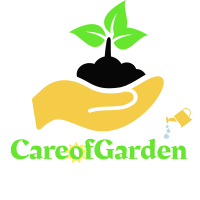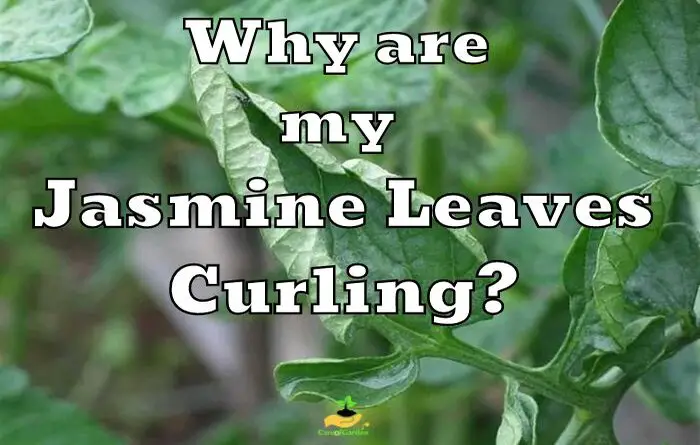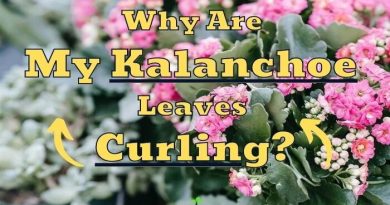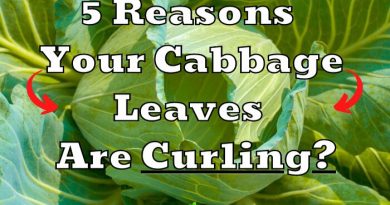Why are my Jasmine Leaves Curling? (Here is the Answer)
Do you have beautiful Jasmine in your house, but do you see that more and more leaves are curling? When you notice that your Jasmine leaves are curling, it can be difficult to understand why this is happening.
Jasmine leaves curl when they do not get enough water or nutrients or are attacked by pests, which causes them to go into a state of stress. To diagnose the problem, inspect the leaves for signs of pests or disease, such as mites, aphids, or fungal infections. Check the soil moisture levels and ensure that the jasmine is receiving adequate sunlight and water. Depending on the cause, you may need to adjust your watering schedule, provide additional nutrients, or treat the plant for pests. With proper care and attention, your jasmine plant can recover and thrive.
Let’s see the causes and remedies required to solve the problem.
| Jasmine leaves curl for the following reasons: |
|---|
| 1. Lack of water |
| 2. Nutrient deficiency |
| 3. Temperature stress |
| 4. Sunburn |
| 5. Aphids |
1. Lack of water
First, a lack of water can cause the leaves on a jasmine plant to curl and begin to fall from their stems. Jasmine that gets too little water will curl its leaves to allow less water to evaporate.
The plant tries to compensate for the lack of water by rolling up its leaves. When exposed to sunlight, less water evaporates. If the plant is still not watered after the leaves have rolled up, they will fall off.
Jasmine that gets too little water will curl its leaves to allow less water to evaporate. Stick a finger in the potting soil and feel: is the soil dry? Then it’s time for some extra water. Other signs of insufficient watering are leaves that droop badly or turn yellow.
You should also try spraying your jasmine plants with a solution of diluted bleach (1 cup per gallon) every few weeks throughout the summer months when you notice your plants are wilting due to low humidity levels or hot weather conditions.
Jasmine is a rather large shrub, sometimes reaching a height of 3 m. The root system of the plant is also quite developed and requires a sufficient amount of moisture.
If the summer is hot and without precipitation, you should water your jasmine more often.
How to treat Lack of Water
The best way to treat curly jasmine leaves is to give them proper amounts of water every day, especially during times when there is not much rainfall or snowfall.
You need to water the culture regularly, and most importantly – plentifully. In the spring, watering is carried out 2 times a week. During the dry period, the amount can be increased up to 3 times.
Note: a plant can show the same symptoms when it has been given too much water. After all, his roots will rot and he can no longer absorb water.
So don’t just get the watering can, but first check the potting soil (and, if necessary, the roots) and check how dry or wet it is.
2. Nutrient deficiency
The second reasons why jasmine leaves are curling is give by the lack of nutrients or excess of fertilizer. With a lack of nutrients, the leaf plate first turns pale, then folds and the leaf dies. It is important to feed in a timely manner, including mineral complexes.
If a jasmine has low levels of molybdenum, manganese, magnesium, potassium, sulfur, nitrogen, copper or boron in its leaves, they will curl up.
If the edges of a jasmine’s leaves curl upward and outward and it becomes mottled on all sides with fine spots, then it lacks zinc.
The balance must also be maintained in the supply of various nutrients to the soil.
Apply fertilizer in a timely manner, in accordance with the instructions, and choose fertilizers suitable for jasmine. Compliance with the recommended doses is very important.
Excess of fertilizer
Another reason why the jasmine shrub curls at the top is excess use of fertilization. If over-fertilized, the top of the plant and any other new shoots will curl inward and the growth may look stunted.
Too much nitrogen in your soil will cause stems to become weak and break, which can lead to leaf curls. This can also happen if you overfeed your jasmine shurb with nutrients during blooming season due to high temperatures or lack of rainwater for irrigation purposes.
Because leaves can curl up due to an overdose of potassium, zinc, nitrogen and other elements, it is important not to exceed the recommended dosage when fertilizing.
How to treat Fertilizer Excess
To correct this, one should water without nutrients for a few days until the growth returns to normal.
If we have put some liquid fertilizer we can water one more time to wash away the substances present in the soil. If, on the other hand, we have put some chicken pelleted manure, in addition to watering, we must manually eliminate the fertilizer.
3. Temperature stress
A common cause of upward curling is temperature stress/change. Especially young still fragile jasmine do not tolerate temperature fluctuations well.
Jasmine shurb will often respond to such stress by curling their leaves becasue they are trying to conserve energy by protecting themselves from getting damaged. This means that they are trying to protect their cell structure against excessive heat or cold, while still being able to function normally.
Lack of air during extreme heat, too much dampness and cold, drafts, sudden changes in temperature: all these factors have a very bad effect on the health of jasmine shrub, causing the leaves to curl outwards. It is simply a way for plants to protect themselves.
For example, jasmine may have been moved away from warm, good conditions in the greenhouse, to wetter and cooler conditions in the open field.
Usually, jasmine placed on windowsills often experiences thermal shock. The reason is that in winter, the glass is cold and in summer it is very hot due to exposure to the direct rays of the sun.
Jasmines in the garden are known to enjoy areas with warm climates, so it’s no coincidence these are the same areas where leaves of this plant tend to curl when there is too much humidity in the air.
Most often, the leaves can begin to spin from the heat, especially if the summer turns out to be dry and watering is not adjusted. Timely moisturizing the bush, you can prevent them from falling off.
Not to the liking of garden jasmine and cold with drafts. If the place does not fit, it is worth transplanting the plant into a more comfortable one, protected from the wind. At the same time, give preference to the sunny side – problems are also possible in the shade, and not only with the leaves.
How to treat Temperature stress
It is especially important to monitor the temperature in the greenhouse. There must be a thermometer in the greenhouse to monitor the air temperature.
Do regular ventilation, do not put the pots in places where direct sunlight falls, do not allow strong drafts. In the open ground, create a shadow for young plants, create a watering regime and water the plants if necessary.
4. Sunburn
Like all flowering plants, jasmine loves light, but prolonged exposure to the sun is dangerous. It can get sunburned, causing the leaves to dry out and curl. This is s due to the plant’s need to decrease sun exposure and water loss.
Often with too much light, especially the older leaves of your plant will curl up, the young leaves will have brown edges and be smaller in size.
Jasmine is photophilous, grows well and blooms profusely in sunny rooms; however, in summer it needs to be shaded from hot sunlight. Jasmine is undemanding to heat. It grows well at a temperature of 68-70°F (20-22°C) and a little lower.
It is recommended to choose a place under the sparse crowns of trees or near buildings so that the jasmine plant stays in the shade for a certain period of daylight hours.
However, this does not mean that you can plant jasmine in a darkened area, such conditions will negatively affect flowering, and the shrub will often get sick.
Do the curled leaves of your plant also look brown, feel ‘crispy’ and is your plant in direct sunlight? Then it is a good idea to place your plant a bit further from the window or in a shadier spot. After a few days, you will see improvements in your jasmine leaves.
5. Aphids
In other cases the curling may be due to the presence of aphids . Pest insects, such as aphids, can distort jasmine leaves and cause them to curl both outwards and inwards. Aphids are soft-bodied insects that are normally found on the underside of leaves and growing tips of the plant.
Aphids, rely on the sap in your plant’s leaves to survive. And the more juice they suck from the leaves, the more they curl up.
Aphids suck all the water out of the plant through the leaves. In this way they ensure that the entire plant dries out. Aphids can also cause your plant to curl its leaves because it has dried out.
So check carefully whether you see unusual spots or small animals anywhere on the leaves. You should be able to spot them with the naked eye. And if you come across them that you do something about it as soon as possible.
How to eliminate Aphids from Jasmine leaves
Their attack causes foliar curling and redness, up to the death of dry leaves and any buds, flowers or fruits. It can be contrasted chemically, or with natural solutions ( such as those listed in this article ). In this case, the ideal solution is a Marseille soap preparation.
If you see any, spray them with insecticidal soap. Repeat until they’re gone. If there is a severe infestation, you can cut back those areas of the plant.
Mix 20 ml of kitchen oil (sunflower oil or olive oil), 1 teaspoon of natural liquid soap, shake well and top up with water until you have 2 liters.
Continue to spray jasmine leaves with the remedy weekly until the aphids insects are gone. You may also want to move them to a different place. This makes it more resistant to insects.
Remember that ladybugs are welcome in the greenhouse, they eat aphids!
Why are Jasmine leaves curling in summer?
Jasmine leaves can curl in summer due to several reasons, including water stress, high temperatures, pests, or diseases. During hot summer months, jasmine plants require more water to stay healthy and hydrated.
If they don’t receive enough water, the leaves may curl and eventually turn brown, starting from the tips and edges of the leaves. High temperatures can also cause the leaves to curl, as the plant tries to conserve water.
Why are Jasmine leaves curling at night?
Jasmine leaves can curl at night due to a natural process known as nyctinasty. Nyctinasty is a plant’s response to changes in light and temperature, causing the leaves to move or fold in response to darkness or low light conditions.
In the case of jasmine plants, the leaves may curl or fold up at night as a way to conserve moisture and protect the plant from cold temperatures.
This is a normal and natural process that occurs in many plant species, and is not usually a cause for concern. However, if the leaves remain curled or show signs of damage or discoloration, it may be a sign of pests, diseases, or other environmental factors that require attention.
Why are Jasmine leaves curling after repotting?
Jasmine leaves can curl after repotting due to a process known as transplant shock. Transplant shock occurs when a plant is moved from one pot or location to another, and experiences stress as a result.
During transplant shock, the plant may lose some of its leaves or experience other symptoms, such as wilting or curling. In the case of jasmine plants, repotting can cause the roots to become disturbed or damaged, which can in turn affect the health and appearance of the leaves.
To minimize transplant shock and prevent curling leaves after repotting, make sure to use a high-quality potting mix, water the plant thoroughly after repotting, and avoid disturbing the roots as much as possible.
How to prevent Jasmine Leaves Curling
To prevent jasmine leaves from curling, it is important to provide the plant with proper care and attention. Here are some tips to help prevent jasmine leaves from curling:
- Water the plant regularly when the top inch of soil feels dry, and ensure it receives 4-6 hours of bright, indirect sunlight daily.
- Use well-draining soil with perlite or vermiculite to improve drainage, and monitor humidity levels with a humidifier or tray of water.
- Avoid over-fertilizing and use a balanced, slow-release fertilizer once or twice per year, following the manufacturer’s instructions.
- Additionally, ensure that your plants are getting enough nutrients and fresh air, and keep humidity levels low by closing doors and windows and using fans to dry rooms after rainfall.
- Don’t let the soil dry out or become too hot or cold, and avoid fertilizing after flowering.
Conclusion
We hope that this article will help you recover your jasmine and that their new leaves will be green and healthy. You now know the reasons that can cause your jasmine to roll up its leaves. If you’re not sure where to start, don’t panic!
Frequently Asked Questions
When the leaves of your houseplant are curling, it is a sign of too little water or too little light. So check what is going on with your plant and give it a little more water, or put it in a lighter spot.
If your plant is too dark, the leaves may curl.
The stems can also become very long, the leaves can fall off or the leaves can discolor.




